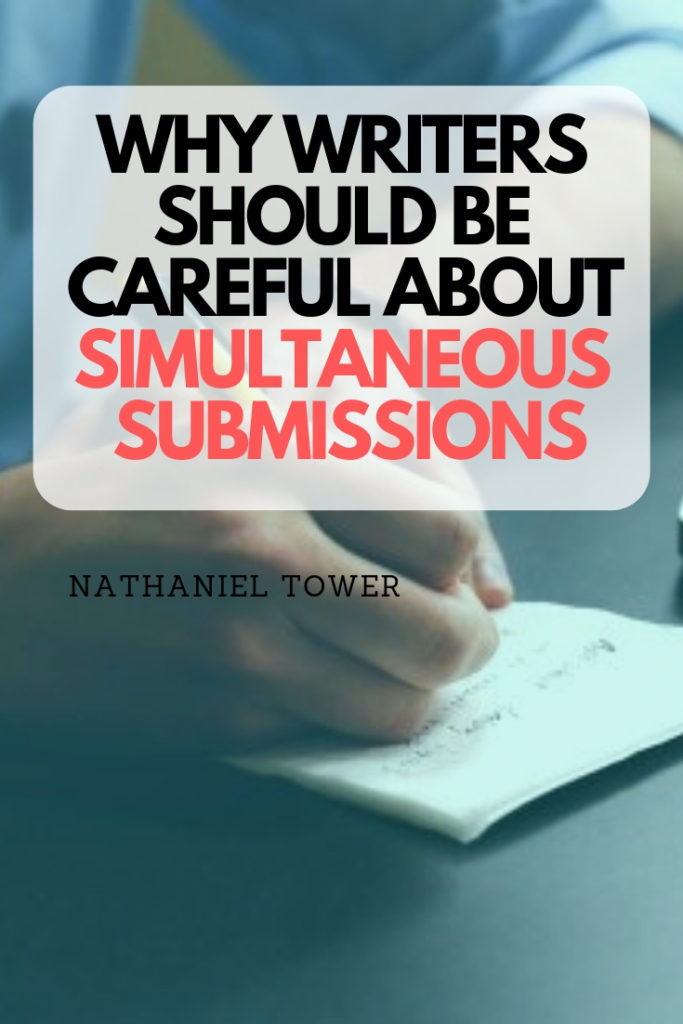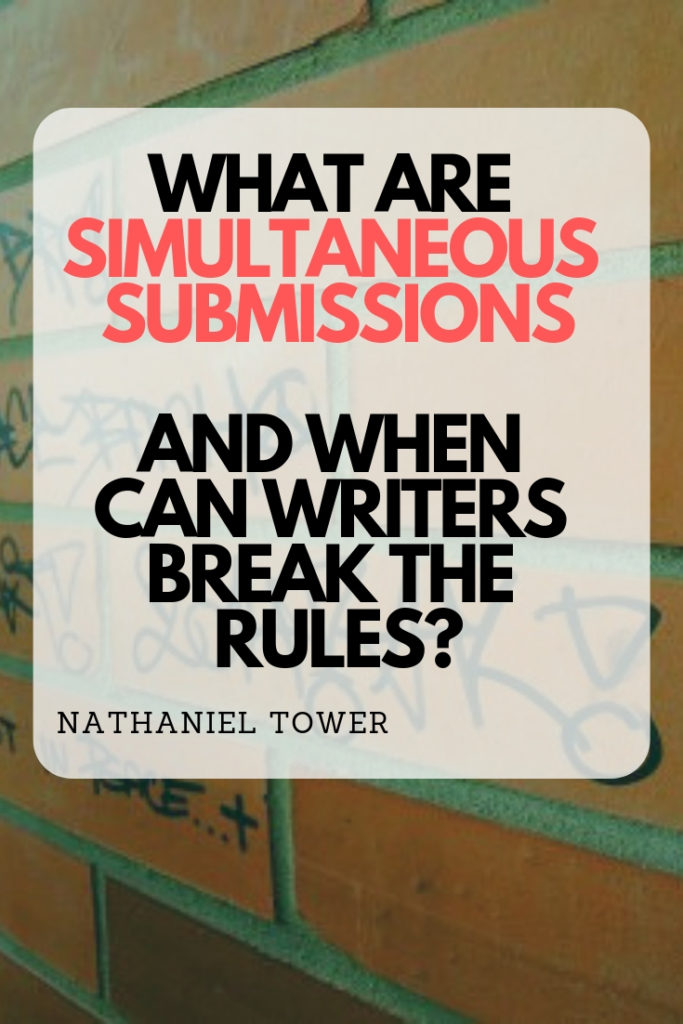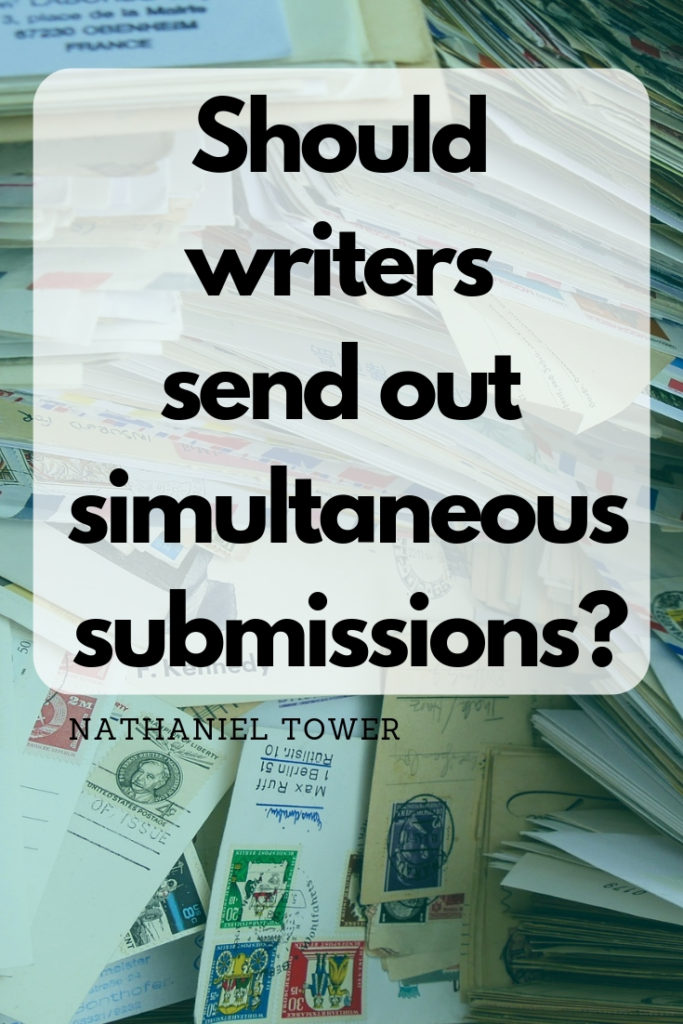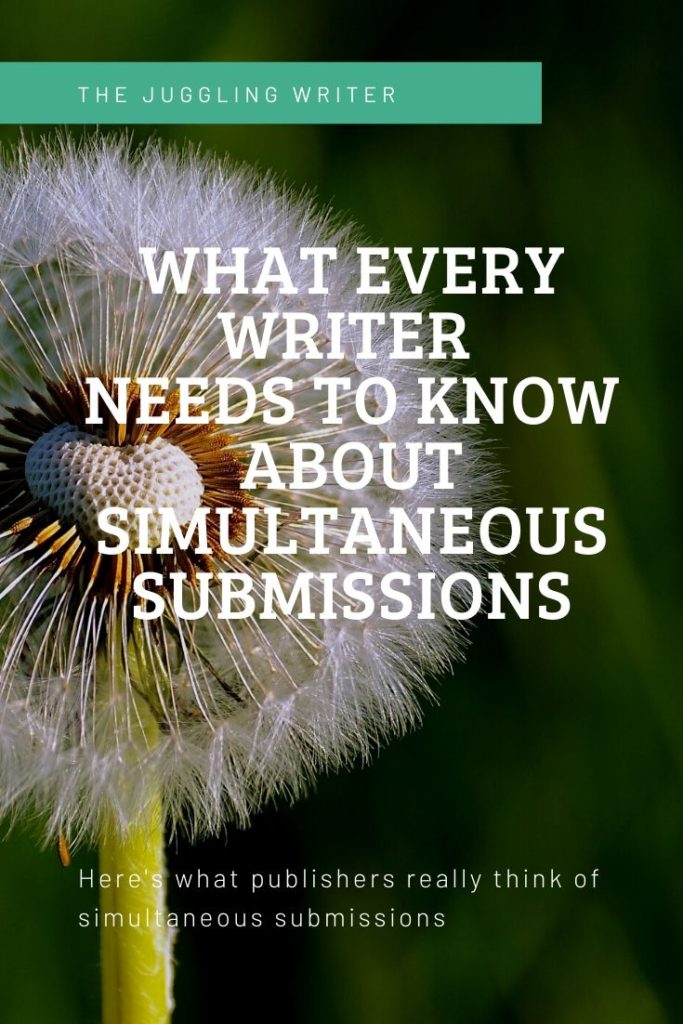Last Updated on July 9, 2024 by Nathaniel Tower
When reading submission guidelines, one of my biggest turn-offs as a writer is the dreaded “NO SIMULTANEOUS SUBMISSIONS.”
This is especially true for those publications with notoriously long response times. Who are these editors to demand an exclusive look at your piece? Would you apply for a job if the employer said you couldn’t apply anywhere else until they made their decision?
It’s very difficult to give away a story completely for months when the odds of it being accepted are slim. If you want to sell your short stories or your novel, then exclusive submissions will drastically reduce your odds of making money. Still, maybe there is something to be said about exclusivity. Or at the very least, being reasonable with the number of places you send a particular piece.
In this post, we are going to explore what simultaneous submissions are, why you shouldn’t overdo them, and why it’s sometimes okay to send them out even when a publication says not to do so.

What Are Simultaneous Submissions
Let’s take a step back and make certain we understand the terminology here. After all, even some publications get this wrong. Chances are, you’ve submitted the same piece to multiple venues at the same time. This is called a simultaneous submission. You are simultaneously submitting one story/poem/work to more than one publisher. In other words, this occurs when the same piece is under consideration at more than one venue simultaneously.
Note that submissions do not literally have to happen at the exact same time to qualify. If you send a story to Publisher A, wait a week, and then send the same story to Publisher B before you’ve heard back from Publisher A, then this is considered a simultaneous submission.
Some people get this confused with multiple submissions, which means you are submitting more than one story/poem/work to the same publisher at the same time. Many publications accept simultaneous submissions. Very few seem to accept multiple submissions.
Submitting simultaneously seems like a great deal for the writer. After all, this is how you increase your chances of getting published, right? If you send the same story to 100 different lit mags, someone surely has to take it.
When You Should Send Out Simultaneous Submissions
Sending out simultaneous submissions will increase your chances of publication. Consider this: on average, any given publication accepts less than 10% of what is submitted. For some publications, it is much lower than that. So if you only send a piece of writing out to one publisher, chances are good it will be rejected. Unfortunately, it often takes a long time to receive that inevitable rejection, which means your story is just sitting around waiting to not get published.
That’s pretty inefficient. So here’s a simple rule regarding when you should send out simultaneous submissions:
Any time you want to get a story or poem published.
Now, there are some obvious exceptions to this rule. If you’ve already sent your story to a venue that doesn’t accept simultaneous submissions, then you shouldn’t send it anywhere else. This is especially true if your story is under consideration for a contest with big prize money. Additionally, you shouldn’t send out a simultaneous submission when you have a story that’s made it to a final round of consideration. In that case, you should be patient and hope for an acceptance.
It’s also pretty easy to overdo simultaneous submissions, so let’s talk about some of the negatives.
Why You Should Be Careful About Submitting Simultaneously

Unfortunately, sending your work to multiple venues at the same time isn’t always a good idea. The practice of submitting the same piece to many different publications has plenty of downsides if you decide to overuse it.
1. Too Many Simultaneous Submissions Will Lower Your Acceptance Rate
As writers, we care (at least a little) about our acceptance rates. The higher our acceptance rates, the better we feel about our output as writers. If you send out the same piece to 25 publishers at once, you will inevitably get more rejections than you would have if you had sent it out to only a few carefully chosen publications. What makes you feel better: 1 acceptance and 4 rejections, or 1 acceptance and 24 rejections?
2. It Can Waste Your Time
Let’s say you are the type of submitter who spends very little time researching a venue before submitting (and if you are sending the same piece out 25 times at once, then you probably are). At an average of five minutes per submission, you are still looking at over two hours spent just on submitting a single piece. In that same amount of time, you could have researched a few publications that were actually a good fit for your story. If you do get lucky and get a quick acceptance from one of those 25, then you are faced with another hour spent withdrawing your piece from dozens of publications.
3. It Wastes an Editor’s Time
Sending out the same short story to dozens of publications at once doesn’t just hurt you. It ultimately wastes the time of the editors to whom you are submitting. Very few stories are a good fit for 25 different venues. Chances are, your story will actually be a terrible fit for most of those venues. In many cases, the editors would’ve been better off not opening your story. This doesn’t necessarily have anything to do with the merits of your story so much as it does the overall aesthetic.
4. It Increases the Odds of Overlap
I’ve seen it happen to several writers. They submit to a bunch of venues and end up with 2 acceptances at virtually the same time. Before they can even respond to the first acceptance email, the second one comes rolling in. Now what? You might have to tell the second editor that he/she didn’t quite grab it in time. No matter what you say, there is going to be a pissed off editor who probably won’t want to read your stuff in the future.
5. They Cause You to Make Bad Decisions
Unless you are sending a piece out to 25 publications of equal caliber, you will inevitably have this happen: your story will be accepted by a second or third tier publication while a top tier (and paying) venue is still considering it. Now what do you do? Do you risk the acceptance you have for the “better” one? I actually know of writers who’ve asked a lit mag to wait because a paying publication might also want to accept it. I’ll let you go ahead and guess what happened.
6. It Puts an Emphasis on Submitting Rather than Writing
When you submit the same piece dozens of times, you are essentially saying that you are a submitter, not a writer. A writer should spend his or her time fine-tuning the story so it’s worthy of publication in the proper venue. A submitter sends out the story everywhere until someone is willing to accept it.
7. It Devalues Lit Mags
You can’t possibly be a reader of 25 different publications. At least not on a regular basis. If you are submitting to all of these places with no desire to read what they publish, then you are essentially saying that you only care about them as publication credits. You should place high value on any magazine you want to consider your work.
8. It Leads to Mistakes
If you send out the same story enough times, you’ll eventually mess up somewhere along the line. You’ll send it to the same publication twice. You’ll send it somewhere that doesn’t allow you to have your work being considered elsewhere. You’ll end up having it published by two different venues who both want first rights. Something will go wrong.
Simultaneous submissions can be very valuable–when they are used wisely. I used to be a submission machine. I once submitted a total of 1000 times in a single calendar year. As you can guess, this led to low acceptance rate and little time spent on writing. Since being more selective with my submissions process, I’ve had a lot more acceptances and a lot fewer rejections.
There’s no set rule for how many publications you should simultaneously submit to, but I would recommend tracking your submissions carefully to make sure you don’t overdo it.
Why It’s Okay to Be a Submissions Rebel
Simultaneous submissions can be a writer’s best friend. After all, your odds of having a story or poem accepted by any given publication are bleak. With many publications boasting acceptance rates anywhere from 5% all the way down to a fraction of a fraction of a percent, you’re probably going to see a great deal of rejections. Might as well improve your chances by submitting simultaneously.

Why Submitting Simultaneously Isn’t That Big of a Deal
In case you skipped it the first time around, a simultaneous submission occurs when you submit the same story/poem/manuscript to multiple publications. You don’t literally have to submit it at the same time. This isn’t a term for some magical way of batch submitting your story to a thousand publications at once. Anytime you have the same piece under consideration by more than one venue, that qualifies.
Imagine for a moment a world in which you can’t submit to more than one publication at a time. You send your story to a journal. They hold your story for six months and then send you a form rejection. Then you send that story to another journal. They wait six months and send you a rejection. You do it again. If you’re lucky, you might get the piece published in a decade or so.
Put simply, submitting to multiple publications at once gives you a better chance of publication. Instead of having one piece tied up by one venue, you can send it to as many venues as you want. If it gets accepted somewhere, you kindly withdraw it from consideration elsewhere. With Submittable, this simply requires the click of a button. For email submissions, it’s as easy as sending a polite note: Dear so and so, I would like to withdraw my submission from consideration. It has been accepted elsewhere. Thank you very much for your time. That’s all you need to say. I promise there won’t be any hard feelings.
The Simultaneous Snobs
Although a simultaneous submission doesn’t hurt anyone, there are some publications out there that refuse to accept them. Or at least they say they don’t accept them. In reality, they cannot police this. There is no way in the world they could know whether or not you have already submitted that story to another venue.
Wait a minute! Are you suggesting we can violate a publication’s guidelines and send out our work simultaneously in spite of them?
Ah, an interesting question you have raised. I have to confess that I’m a stickler for submission guidelines. As managing editor at Bartleby Snopes, I admit to getting a bit cheesed off by submissions that don’t follow the guidelines. As a writer, I do my best to follow every part of the guidelines down to a T. If they want the manuscript double-spaced, I double space it. If they don’t want previously published work, I don’t send something that’s been previously published. If they want the story saved as an RTF, I save it as an RTF. If they don’t want any sort of identifiable information on the manuscript, I make sure my name, email, phone number, etc. aren’t anywhere on there.
So why should guidelines regarding submitting simultaneously be any different?
Well, I’m not necessarily saying they should. But it certainly isn’t the worst thing in the world if you do decide to bend this particular rule.
Of the 1,000 or so submissions I’ve sent out in the past decade, I’ve probably only violated this rule a handful of times. Yup, that’s right. I’ve submitted simultaneously to publications that don’t allow such a practice. Sometimes it’s been by accident, but other times I just said, “Screw it!” And you know what? No one ever got hurt. I even had a simultaneously submitted piece accepted and withdrew it from one of those venues. As you can imagine, the editors weren’t too happy with me. I received some sort of nasty response asking how could I dare to violate their sacred covenant. But that was the extent of it. I wasn’t added to some literary blacklist. That publication didn’t implode. The sun rose the next day, and the world continued to turn.

A Waste of Everyone’s Time?
Let’s think about the theory behind “no simultaneous submissions” for a moment. It’s a simple theory: A publication doesn’t want to waste their time considering a piece that might be withdrawn.
Okay, that makes sense. It’s pretty infuriating as an editor when I accept a story only to have the author reply, “Uh, this just got accepted elsewhere a fraction of a second before you sent your acceptance, so I’m going to have to withdraw it.”
Well, that’s a pretty big waste of my time, right? If we didn’t let writers have their work under consideration at more than one venue at a time, we wouldn’t have experienced such heartbreak after investing the time to read the story, discuss the merits of the story, send the acceptance, and begin the preparation for publication. What if I had based my entire next issue around that particular piece that was unfairly ripped from my publishing hands? I’d really be screwed now. Curse those darn submitters!
Then again, what makes an editor’s time so sacred that they can’t be bothered to consider a story that’s good enough to be accepted elsewhere. If it’s that good, they should want the chance to read it. Hell, they should beg to publish it. A publication cannot exist without something to publish.
Honestly, I almost never submit to publications that don’t accept a simultaneous submission. Part of this is because I don’t think any publication deserves exclusivity. Imagine if you’re applying for a job that demands you not apply anywhere else at the same time. How likely are you to finish that job application and tie up your job prospects for however long it takes them to go through the hiring process?
I value my work too much to tell one particular venue that they can have sole possession of it while they hide it in their enormous slush pile for months.
The One Submission Guideline That’s Okay to Break
Violating a “no simultaneous submission” rule is a lot different than breaking any other submission guideline. If you don’t format your manuscript the right way, they’ll see it. If you send a previously published piece, you are potentially breaking a copyright issue. If you send a story that’s too long, you are submitting a piece that directly violates what they want to see in a piece. But if you send your work out simultaneously to multiple venues, there is a fraction of a chance that you might have to withdraw it. Given that most publications spend less than five minutes considering any given piece, you certainly aren’t creating too big of an inconvenience. They won’t ever know except in that rare case you get the acceptance elsewhere.
So I say go ahead and send simultaneous submissions to publications that tell you not to. You aren’t going to hurt anyone. The worst case scenario is that a publication will tell you not to submit to them ever again. But that’s after you’ve received an acceptance elsewhere, leaving you with a published story and thousands of other less uptight publications to send your work to in the future. That doesn’t sound bad at all.
Personally, I’ll probably continue not to send my work to venues that demand this ridiculous exclusivity. I have better things to do with my time.
What do you think of publications with a hard and fast “no simultaneous submissions” rule? What are your rules for submissions? Share your thoughts in the comments. And don’t forget to share this post on all your favorite channels.


Simultaneous Submission FAQ
What are simultaneous submissions?
A simultaneous submission occurs when you submit the same piece to multiple venues at the same time. You are simultaneously submitting one story/poem/work to more than one publisher. In other words, this occurs when the same piece is under consideration at more than one venue simultaneously. Note that submissions do not literally have to happen at the exact same time to qualify. If you send a story to Publisher A, wait a week, and then send the same story to Publisher B before you’ve heard back from Publisher A, then this is considered a simultaneous submission.
What are multiple submissions?
Multiple submissions occur when you are submitting more than one story/poem/work to the same publisher at the same time. Many publications accept simultaneous submissions. Very few seem to accept multiple submissions.
Is it acceptable to send a story to more than one publisher at the same time?
Yes, it's common practice to submit a story or poem to multiple publishers at the same time, provided their guidelines indicate they accept simultaneous submissions. As a courtesy to each publisher, you should let them know it is a simultaneous submission, and you should withdraw it immediately if it is accepted elsewhere.
How many simultaneous submissions can you send out?
There is no limit to how many publications you can send the same story to at once, but you don't want to overdo it. Best practice is to keep it under 10 at any given time. Any more and you will have a tough time keeping track.


Good points, all! But I think it’s interesting how many of these points aren’t really an argument for caution regarding sim subs, but an argument for careful selection of the places you submit to in the first place. I think what many of these points boil down to is this: if you’re sincerely reading lit mags, as both a reader and a writer, and you’re selecting your venues based on how they and your story fit together, you’re not going to be sending the same story out to 25 places at once, regardless. Yes?
Sam, thank you for reading and commenting. I think the two definitely go hand-in-hand. Choosing your venues carefully will lead to more (and better) publications than tons of simultaneous submissions. If you choose your submissions wisely, you will find that you can’t send the same story out to 25 places. I think you’ve found the secret of my post. It doesn’t matter how many simultaneous submissions you send out. What matters is how much true effort you are putting into your submissions.
“What matters is how much true effort you are putting into your submissions.”
Yes! That. 🙂
I’m always surprised by how many people ignore the rules and sim sub anyway. I never do that if a venue says it’s not allowed, as I respect them.
When I do sim sub, it’s just two or rarely three places that I’ve carefully researched. But mostly, I just send one place at a time. The ones that want to keep it 9 months exclusively I don’t submit to often, but sometimes. I’m definitely a reader of over 25 publications, though I can’t spend as much money as I’d like on buying issues, so I tend to submit a lot to online mags that aren’t high tier or high paying, because I wouldn’t want to sub someplace I hadn’t read well, as that would just take up editors’ time.
Tantra, thank you for reading and commenting. I think it’s fantastic that you are a reader of over 25 publications. Unfortunately, I think you are in the minority. Many writers are just submission dumpers. They submit and run off to the next publication. Thank you for supporting us!
Hello,
This summer I have submitted to 7 literary agents. I have 2 rejections so far. I probably won’t send any more until September. I’m so busy getting my chapters as clean as I can, I want to take it slowly. Say you?
Tracy
You literally just saved me from making myself look like a fool! I thought that multiple submissions and simultaneous submissions were the same thing! I just about wrote, “This is not currently a multiple submission.” It sounds like some sort of bizarre threat X’D Like, “If you don’t like this one, I WILL be sending you more!” XD XD
I used to write poems back in college MANY moons ago and had 2 of them published in our college magazine. When real life came calling, I put the poetry on hold. 30 years later, I’m writing poems again. In my furious desire to play catch up, I sim-subbed for months without actually reading a lot of magazines. Not 100% my fault, though. Some magazines post their work online, for others you have to buy their issues. Sorry, I’m not Rockefeller’s grandson. I’ve since learned to streamline my sim-subs by carefully viewing what magazines post online. Poetry itself is an interesting medium. Styles can range from pleasantly accessible to so obscure that only three people in the world could appreciate it. Quite a few literary mags veer towards the nearly obscure without going off the deep end. When I run into those guys, I try to format my work to their level of tightness and symbolism. It has worked and I end up having to only sim-sub to 3 or 4 magazines to get accepted.
I’m in exactly the same situation. I’m now retired, and have plenty of time to devote to my arts. Do people really pay money for poems and drawings or paintings? Do they just offer you a price, or do you have to charge them?
Excellent advice. Just what I’ve been looking for. The publisher who recently received my sole-source query letter requires an eight-week wait to hear back–even before they see the manuscript. No. Can’t do it. I’m back to reviewing the publisher lists.
It is an excellent analysis. Thank you. Two points.
I have a question if you don’t mind. How would you differentiate between a top-tier publisher for my up coming book, from a second/third-rate one?
Second remark: You did not address the ‘literary agent’ role!
Thanks again.